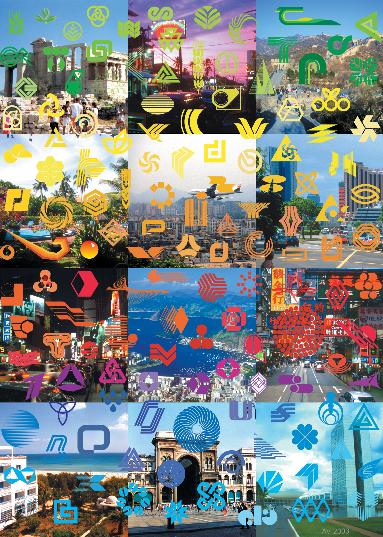Form-Specific
dal 30/5/2003 al 31/7/2003
Segnalato da
Yuri Avvakumov
Angela Bulloch
Daniel Buren
EXAT 51
Bernardo Bernardi
Zdravko Bregovac
Vlado Kristl
Ivan Picelj
Zvonimir Radic
Bozidar Rasica
Miroslav Richter
Aleksandar Srnec
Vladimir Zarahovic
Liam Gillick
Edward Krasinski
Luisa Lambri
Marko Lulic
Mathieu Mercier
Sarah Morris
Olaf Nicolai
Helio Oiticica
Marko Peljhan
Tadej Pogacar
Marjetica Potrc
Florian Pumhosl
Tobias Rehberger
Apolonija Sustersic
Jacques Tati
Fiona Meadows
Lisa de Visscher
Anton Vidokle
Dusan Vukotic
Zdenka Badovinac
30/5/2003
Form-Specific
Moderna Galerija Museum of Modern Art, Ljubljana
The exhibition aims to synthesize the experience of high modernism, which strove for pure, autonomous forms, and of post-Conceptual art and its determination by specific experiences of time and space.

Yuri Avvakumov, Angela Bulloch, Daniel Buren, EXAT 51 (Bernardo Bernardi,
Zdravko Bregovac, Vlado Kristl, Ivan Picelj, Zvonimir Radic;, Božidar
Rašica, Miroslav Richter, Aleksandar Srnec, Vladimir Zarahovic;), Liam
Gillick, Edward Krasinski, Luisa Lambri, Marko Lulic;, Mathieu Mercier,
Sarah Morris, Olaf Nicolai, Hélio Oiticica, Marko Peljhan, Tadej Pogac;ar &
the P.A.R.A.S.I.T.E. Museum of Contemporary Art, Marjetica Potrc;, Florian
Pumhösl, Tobias Rehberger, Apolonija Šušteršic;, Jacques Tati/presented by
Fiona Meadows and Lisa de Visscher, Anton Vidokle, Dušan Vukotic;
Curator: Zdenka Badovinac
The exhibition Form-Specific aims to synthesize the experience of high
modernism, which strove for pure, autonomous forms, and of post-Conceptual
art and its determination by specific experiences of time and space.
At a time when we are becoming increasingly aware of how quickly the world
can be homogenized, and the fear of a possible disappearance of the
specific differences of its various spaces is beginning to rear its head,
we must learn to recognize form as a tool and as a weapon of
communication. The more canonized the graphic signs, forms, and colors,
the more general the consensus behind them, and the more significant the
relations of power discernible from the extent and the ways of using form.
No matter how universal a given form may appear, we must now point out its
specific aspects, at least in terms of its use, perception or
interpretation. To present this fact, the exhibition Form-Specific wishes
to use the example of some of historical works from both Western and
various marginal contexts. Naturally, also this retrospect view is taken
from the present-day standpoint of thinking about form and its temporal
and spatial determination. Even though this exhibition does not wish to
put forward form as an abstract or autonomous entity, it may well repeat
the experience of modernist (Minimalist) art to a great extent. Yet,
rather than speaking of what is visible (what you see is what you see),
present-day works, at times reminiscent of Minimalist works shorn of
particular thoughts and personal emotions, address that which is not
visible. With their apparently pure forms, current works do not speak of
universal laws; instead, they refer to some sort of immaculate
laboratories in which science descends from the pedestal of pure thought
and becomes involved in the production of substance, both for the
improvement and for the destruction of the world.
Whereas modernist works strove to attain the utmost in purity and autonomy
of form, form-specific works underscore the fact that various forms may be
viewed from the point of their usefulness, their social life as it were,
which is very important in the increasingly codified world of global
communications. While site-specific works were based on their interaction
with the viewer and the space, form-specific works focus on a relatively
free use of existing forms in terms of their repetition within a different
spatial and time frame. Although a given form is repeated because of its
particularity, the universality of its understanding is at risk every time
it is repeated. Every use of a given form potentially jeopardizes the
system within which it has originated, as there is no guarantee it will be
universally understood in the sense presupposed by the system. Its
repetition in the context of a work of art can thus be an articulation of
new spaces of freedom, of a free manipulation with the existing signs of
an increasingly formalized world.
Zdenka Badovinac
The exhibition, which is conceived and organised by Moderna galerija,
will be placed at its new premises, an as yet not renowated building in
the complex of the former Yugoslav Army barracks, where, in 2000, the
first display of the collection Arteast 2000+ was staged. The first
display of the new collection of Moderna galerija Arteast 2000+ emphasized
a dialog between East and West Europe and offered the most comprehensive
overview so far of East European art based on the experience of
Conceptualism from the 1960s to the present. Among other things, the
exhibition Form – Specific will also provide an opportunity to consider
the possible directions for the future development of the Arteast 2000+
collection.
More info: Adela Železnik, Moderna galerija, Tel: 0038612416808
Moderna galerija/Museum of Modern Art, Tomsiceva 14, 1000 Ljubljana, Slovenia
Tel: +386(0)12416800, Fax: +386(0)12514120



